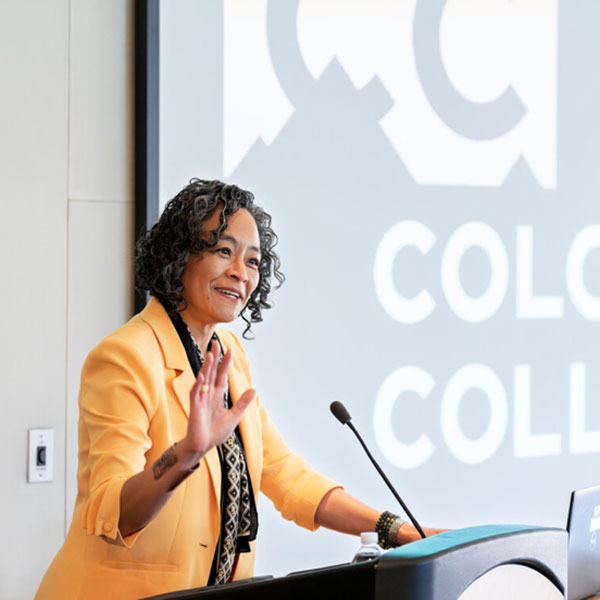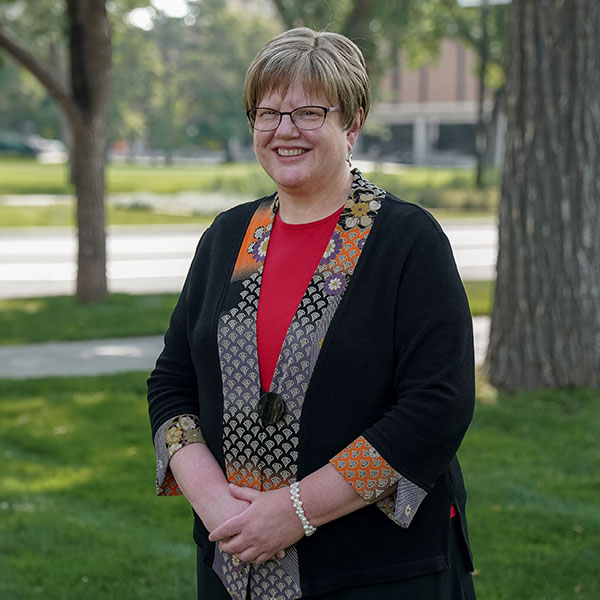CC Thought Leaders in the Conversation

— CC President L. Song Richardson, panelist at the National Summit on Equal Opportunity in Higher Education, U.S. Department of Education, Washington, D.C. 7/26/23“We at Colorado College, because of the unique educational experiences that we provide to our students, have been thinking about access and opportunity long before the court's decision. We will not stop and we will follow the law.”
CC President L. Song Richardson speaks at the National Summit on Equal Opportunity in Higher Education which was hosted by the U.S. Department of Education on July 26, 2023.
CC in the Media
9/28/23 | The Colorado Department of Higher Education | Colorado Department of Higher Education stands with Colorado College in supporting students that face inequities in other states. CDHE shared a statement of support of CC's HAVEN initiative with its constituents and encouraged all institutions of higher learning to follow suit.
9/14/23 | The Chronicle of Higher Education | Colorado College Encourages Students to Transfer from States with Anti-DEI Laws with the announcement of the HAVEN initiative, or Healing and Affirming Village Empowerment Network.
7/28/23 | University Business | "Affirmative action made us complacent." CC President L. Song Richardson's statement is the headline of this article featuring her comments as a panelist at the National Summit on Equal Opportunity in Higher Education hosted by the U.S. Department of Education in Washington, D.C.
7/27/23 | Inside Higher Ed | CC President L. Song Richardson is quoted in this article which focuses on frustration and uncertainty at the affirmative action summit where higher ed leaders searched for a path forward.
7/26/23 | Wall Street Journal | Colorado College is featured prominently in this article about what happens next for diversity in higher education admissions. Dean of Admission Karen Kristof was interviewed for this piece, with a reach of 171M.
7/26/23 | Marketwatch | "Fix the broken and inequitable education system," says CC President L. Song Richardson at the national education summit, as quoted by Marketwatch, which also features the U.S. Secretary of Education Miguel Cardona. This piece garnered a reach of 15M.
7/12/23 | NPR | Dean of Admission Karen Kristof is a guest on 1A (4M listeners/1M downloads) participating in a discussion about how college admissions officers are assessing applicants in light of the recent U.S. Supreme Court decision.
7/08/23 | New York Times | President L. Song Richardson's opinions are sought out for this Q & A about higher education in light of SCOTUS striking down affirmative action. A reader asks about a lottery system for admissions.
6/29/23 | New York Times | President L. Song Richardson is featured and photographed in this article about how college admissions could become more subjective with the U.S. Supreme Court’s decision on affirmative action. This story has a powerful reach of 137M views.
See more of Colorado College in the media related to affirmative action »
Community Conversation
CC staff and faculty held a panel discussion on Monday, May 8, 2023, weighing in on the impending SCOTUS decision on affirmative action. Listen in more detail as moderator Doug Edlin, political science professor, poses questions to panelists Rosalie Rodriguez, senior associate dean for student equity and inclusion, Karen Kristof, assistant vice president and dean of admission, and Christina Leza, associate professor of anthropology.
what is affirmative action
In the United States, affirmative action is an effort to improve educational and employment opportunities for historically underrepresented groups including people of color, women, and individuals with disabilities. As more colleges and universities began to admit more students of color as part of a broader social reform movement in the 1960s and 1970s, these institutions shifted to race-conscious admissions, which considers race as one factor among many, to achieve greater diversity.
From the WSJ: Supreme Court Bans Affirmative Action: What It Means for College Admissions
A closer look
Colorado College Professor of Political Science and McHugh Professor of American Institutions and Leadership Doug Edlin takes a closer look at affirmative action and where it stands now. (View as PDF)
Our support of the Liberal Arts Colleges Racial Equity Leadership Alliance (LACRELA) statement
CC Affirmative Action FAQ
Q: Does the new ruling change any processes or exclusions for students wishing to join or create an affinity-based student organization or multicultural fraternity/sorority?
A: No. The ruling is limited to the consideration of race as a part of admission to colleges and universities. The ruling has no bearing on national fraternities and sororities which have a selection process and do not receive federal funding. For clubs and organizations, it has always been the case that any program which receives federal funding must be open to anyone. This does not mean that these groups cannot focus their time, their name, resources, or activities on a specific identity or culturally relevant guiding principles.
Q: Can student organizations, co-curricular offices in student life, and academic programs still offer affinity-based programming such as BIPOC specific trips, guest speakers, meeting spaces for individual identity groups, and events celebrating cultural and racial diversity?
A: The SCOTUS ruling eliminates race as a consideration for admission to college only. There is no reason to stop offering multicultural, identity, or affinity-based programming, including employee resource groups (ERGs). Recent guidance from the U.S. Department of Education states, “Title VI generally does not restrict schools from holding assemblies, meetings, focus groups, or listening sessions that relate to students’ experiences with race in their school or community… school-sponsored or recognized groups or programs with a special emphasis on race, such as a student club or mentorship opportunity, that are open to all students, typically do not violate Title VI simply because of a race-related theme.”
Q: Does the ruling change how Admissions will recruit students?
A: We will continue to sustain our partnerships with community-based organizations and high schools as well as using other marketing efforts (social media, for example). We have also begun identifying new partnerships which will help CC recruit the diverse student body we are committed to.
Q: Will the Office of Admission still report statistics on the demographics of the entering first-year and transfer classes, including race?
A: Applicants can self-identify race and ethnic background. However, this information will not be visible in the evaluation process. The collected demographic information will be used to provide federally mandated data on applicants, admitted students, and enrolling students.
Q: How will the Office of Admission change its evaluation process?
A: Per the SCOTUS decision, applicants may discuss their background, experiences, and the challenges that they have encountered and potentially overcome, which make them who they are. We will continue to look for individuals who align with CC's values of antiracism, wellness, and sustainability. We will evaluate students as we have always done, holistically and within the limits of the law. We are committed to bringing diverse perspectives to CC education. For more specific admissions related questions please visit the Colorado College Office of Admission webpage.
Q: How will the SCOTUS decision impact the Stroud Scholars Program?
A: The Court’s decision addresses the college and university application and selection process. As a program designed to support high school students and prepare them for selective college environments, the decision does not affect the Stroud Scholars Program.
The Stroud Scholars Program will continue to partner with local schools and community organizations to engage with high promise youth from a wide range of diverse backgrounds and lived experiences.
Q: How will the SCOTUS decision impact the Bridge Scholars Program?
A: Just as the Stroud Scholars Program is geared toward students before they apply to college, the Bridge Scholars Program provides mentorship opportunities, together with academic and social support, for students after they have been accepted and enrolled at CC. Since the Court’s decision addresses the college and university admissions process, the Bridge Scholars Program will not be affected by the decision.
Q: What sort of impact will the SCOTUS decision have on hiring employees?
A: The Court’s judgment is limited to college and university admissions, and therefore does not address or impact hiring processes or employment decisions. Although the Court may take an approach to employment and hiring that is similar to its judgment about admissions, we will have to see what the Court does in the future.
Q: Does the ruling mean we cannot teach about race or racism in the classroom.
A: No. The Court’s ruling does not preclude any discussion of race or racism in the classroom.
Q: How will the decision impact athletics recruitment?
A: Changes to athletic recruitment will be minimal. The SCOTUS decision impacts how we admit students, but it doesn't impact how we recruit students. Athletic department leadership and coaches will continue to partner with our Admission staff to identify and recruit highly qualified student-athletes, including highly qualified student-athletes of color. NCAA student-athletes typically make up around 20% of the student population at CC and we are committed to supporting the overall compositional diversity goals of Colorado College.
If you have any additional questions, please email the CC ADEI Team.




